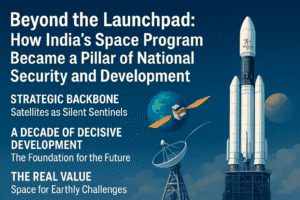Beyond the Launchpad: How India’s Space Program Became a Pillar of National Security and Development
India’s space program has fundamentally evolved, becoming an indispensable pillar of national security and development. The successful integration of its satellite constellations—like the navigational NavIC, all-weather surveillance RISAT, and communication GSAT networks—was proven critical in strategic operations, showcasing a decade of focused technological advancement.
This prowess now serves as a springboard for an ambitious future, including crewed spaceflight, a space station, and lunar exploration. However, the true value extends beyond prestige; the strategic roadmap explicitly leverages space technology to address earthly challenges like food security, disaster management, and sustainable growth. This creates a powerful synergy, where strategic capabilities validate investment, which in turn fuels innovations that directly improve citizen welfare and drive inclusive development.

Beyond the Launchpad: How India’s Space Program Became a Pillar of National Security and Development
The announcement by Space Minister Jitendra Singh on National Space Day was more than a routine update; it was a definitive statement on the maturation of India’s space ambitions. By explicitly linking the success of a military operation, known as “Operation Sindoor,” to advancements in space technology, the minister illuminated a critical shift: India’s celestial endeavors are now deeply integrated with its terrestrial security and economic prosperity.
This revelation moves the conversation beyond rockets and satellites, framing them not as isolated marvels of science but as foundational tools for a modern nation.
The Strategic Backbone: Satellites as Silent Sentinels
The minister’s reference to Operation Sindoor—understood to be the military response to the Pahalgam terror attack—highlights a seamless, space-enabled defense infrastructure. As ISRO Chairman V. Narayanan noted, at least ten satellites work around the clock for strategic purposes. This isn’t a vague concept; each satellite plays a specific, critical role:
- NavIC (Navigation with Indian Constellation): This homegrown alternative to GPS provides encrypted, highly accurate navigation signals. It’s the digital map that guides precision munitions to their targets, ensuring strategic autonomy and reducing reliance on foreign systems.
- RISAT (Radar Imaging Satellite): Unlike optical satellites, radar satellites like RISAT can see through cloud cover, darkness, and rain. This provides relentless, all-weather surveillance and earth observation, crucial for monitoring activities and terrain, day or night.
- GSAT & INSAT: These communication and meteorological satellites form the nervous system. They secure communication channels for the armed forces and provide real-time weather data, which is vital for planning any operation.
The key insight here is integration. The “energy of two key departments”—Space and Atomic Energy—signals a convergence of technological might. It’s the combination of navigation, eyes in the sky, and secure communication that creates a decisive strategic advantage.
A Decade of Decisive Development: The Foundation for the Future
Minister Singh was deliberate in his timeline, crediting these capabilities to developments over “the last 10 years.” This period of intense focus on technology development and transfer has created a powerful feedback loop. Missions like Chandrayaan and Mangalyaan were not just for prestige; they served as demanding proving grounds for the precise engineering, deep-space communication, and robust systems now being leveraged for national security.
This established prowess is the springboard for an extraordinarily ambitious future roadmap:
- Human Spaceflight: The planned uncrewed Gaganyaan-1 mission this year, leading to a two-astronaut crewed flight in 2027, will cement India’s place as a leading spacefaring nation.
- Interplanetary Ambitions: Chandrayaan-4 in 2028 and a mission to Venus demonstrate a sustained commitment to planetary science and exploration.
- The Bharat Antariksh Station by 2035: A sustained human presence in low-Earth orbit is the next logical step, serving as a platform for microgravity research and deeper space missions.
- An Indian on the Moon by 2040: This goal is positioned not just as a scientific achievement, but as a symbolic marker of India’s arrival as a developed nation by 2047.
The Real Value: Space for Earthly Challenges
Perhaps the most significant takeaway is the government’s clear vision for applying space technology to everyday challenges. The released 15-year roadmap explicitly ties the launch of over 100 public and private satellites to tangible benefits for citizens:
- Food and Water Security: Satellite data can monitor crop health, predict yields, and manage water resources with incredible precision.
- Disaster Resilience: From predicting cyclone paths to assessing flood damage and coordinating relief efforts, satellites are indispensable first responders.
- Environmental Sustainability: Monitoring deforestation, tracking air and water quality, and measuring the impacts of climate change are all enabled by space-based observation.
- Inclusive Growth: Satellite communication can bridge the digital divide, bringing education, telemedicine, and information to the most remote villages.
The Human Insight: A Symbiotic Ecosystem
The true value of this news lies in understanding the symbiotic relationship now in play. Strategic operations like Operation Sindoor validate the technological investment, which in turn secures funding and public support for the peaceful, scientific, and societal applications of space tech. One fuels the other.
India’s space narrative is evolving from one of cost-effective discovery to one of comprehensive capability. It’s a story about how investments in looking up at the stars have given the nation sharper eyes, better ears, and a more powerful voice right here on Earth. The final frontier is no longer a distant dream—it’s a practical toolset being used to build a more secure, prosperous, and resilient nation.
You must be logged in to post a comment.